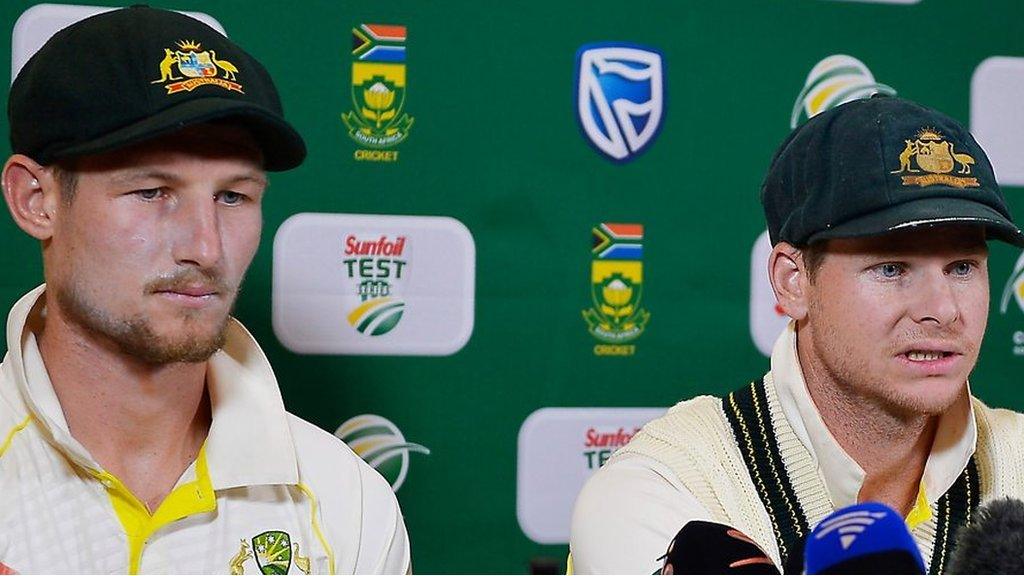Australia ball-tampering row: What is it and why is it so serious?
- Published
Watch: Bancroft and Smith admit ball-tampering plan
Hands up if you know how many runs South Africa won the third Test against Australia by? Or if you knew what the score was on day three? Or if, prior to Saturday, you knew there was a third Test going on?
Whatever your view on the ball-tampering saga - funny, pathetic, reprehensible or a mix of all three - it's impossible to deny it has overshadowed a potentially great series.
Captain Steve Smith and Cameron Bancroft's admission on Saturday that Australia had a premeditated plan to tamper with the ball turned the Test into a circus.
The two have been sanctioned by the International Cricket Council, but that will only be the beginning of the fall-out.
So what is the reason for ball-tampering? Is it as serious as it has been made out to be? And have Australia, with their talk of "the line" and knowing where it's drawn, brought extra scorn on themselves?
What is ball-tampering?
Level two offences - of which Smith and Bancroft were found guilty - are serious. There are four levels under the ICC's code of conduct, which takes guidance from a cricket committee that includes former players and umpiring representatives, with four being the highest in terms of severity.
And ball-tampering - which often results in a team being able to utilise reverse swing, where the ball moves through the air at high speed towards a batsman - happens more often than people realise.
Roughing up one side of the ball can be achieved by, say, a fielder out on the boundary throwing the ball in on the bounce into a rough part of the square. Sometimes, those stationed close might bounce the ball to the keeper.
While throwing the ball on the bounce is not illegal, umpires are quick to warn a fielding side if they believe it is being done to alter the state of the ball.
Australia ball-tampering row: Simon Hughes explains what happened in Cape Town
Sweets or sun-cream can be used for the shiny side of the ball. Marcus Trescothick, the chief shiner of the ball during the 2005 Ashes, wrote in his autobiography, external that he used Murray Mints to produce saliva that would shine the ball effectively.
Under the laws, players must not apply artificial substances to the ball.
A recent piece on Cricinfo, external said that ball-tampering was not as uncommon as you might think. And yet, these incidents aren't widely condemned.
Not walking when you know you've edged the ball. Claiming a catch you know isn't clean. Doctoring a pitch for home advantage. These are all forms of cheating in the eyes of many.
To use Australia spinner Nathan Lyon's phrase, they are incidents that at the very least "headbutt the line" of what is right and wrong.
But they happen in cricket all the time. Ball-tampering, though, is seen to be deliberately duplicitous. Australia's pre-meditation to meddle with the ball somehow makes the whole thing more unpalatable for fans.
Why has the backlash been so severe?
Australian cheating beyond belief - PM Turnbull
"I'd be very disappointed if one of our team members did that. The rules are in place for a reason - if you're not going to use them, then why bother having them?"
Not a comment from the past few days. It's what David Warner said, external in 2016, when asked to comment about South Africa captain Faf du Plessis' fine for ball-tampering in a Test between the sides.
Sixteen months is a long time in cricket. Warner stood down as vice-captain before the final day's play in Cape Town due to his role in the "leadership group" that decided to tamper with the ball on Saturday afternoon.
Warner's comments, while ironic now, may give some insight into why Australia's actions have been roundly condemned.
"This Australian team are so friendless in cricket because of the way they have carried on," ex-England spinner Graeme Swann told BBC Radio 5 live.
"They have set themselves as this higher-than-high, pious team who set the benchmark for what is right and what is wrong in cricket, when everyone who has played against them knows it's an absolute joke."
This series was already in a mire of unpleasantness before that little piece of yellow tape appeared. Players have been banned, fined, then allowed to play after lengthy appeals.
There was a heated argument in a corridor; misogynist shaming, external of Warner's wife, Candice, and crowd abuse described as "unacceptable" by coach Darren Lehmann - the same Lehmann who asked Australia's fans to send Stuart Broad home in tears from the 2013-14 Ashes.
But this Australian team have shaped themselves around playing hard. Off-spinner Lyon said the side hoped to "end careers" in the recent Ashes series. Sledging in that series overstepped the mark, according to former wicketkeeper Matt Prior. Because of this, it makes it difficult to garner sympathy for Australia.
"The behaviour of some of the players in the current South Africa/Australia series, and other incidents in recent times in the game we all cherish, has fallen well below the standard required to inspire future generations of cricket-loving families," an MCC statement read on Monday.
That may be the crux of the issue. Everything has come to a head around this one issue of ball-tampering - an issue that is always controversial - and the ramifications have been far more than Australia could have anticipated.
What are the laws?
Smith's punishment was for his conduct, which was "of a serious nature that is contrary to the spirit of the game". Bancroft's was for the physical act of ball-tampering.
Social media has been abuzz with people claiming the punishments are light. But they are in line with the laws.
Bancroft was given three demerit points, just as Du Plessis was when he was found guilty in 2016. Du Plessis was also fined 100% of his match fee, just as Smith was. Smith has also been banned, which shows his extra accountability as captain.
Examples of offences at the different levels include:
Level one offences: Excessive appealing, showing dissent at umpire's decision
Level two offences: Using language that is seriously obscene or offensive, inappropriate or deliberate physical contact
Level three offences: Threat of assault on another player, intimidation of umpire or match referee
Level four offences: Threat of assault on umpire or match referee, physical assault of another player
Punishments for ball tampering have varied. Shahid Afridi was banned for two Twenty20 matches in 2010 for apparently biting the ball. Then-England captain Mike Atherton was fined £2,000 in 1994 but his defence was he was trying to maintain the ball's condition.
Proteas pace bowler Kagiso Rabada was charged with a level two breach of conduct when he shoulder-bumped Smith in the second Test. He was banned for two Tests due to reaching eight demerit points, but it was overturned on appeal.
Smith and Bancroft will also be punished by their own governing body. And, given the comments made by Cricket Australia CEO James Sutherland, those punishments may be more severe.
Sutherland wrote an open letter on Sunday, apologising to the fans who had been "let down".
"This behaviour calls into question the integrity of the team and Cricket Australia," he said.
"We know how you feel and have heard your feedback loud and clear. We share your anger and disappointment. All Australians, like us, want answers and we will keep you updated on our findings, as a matter of urgency."
Hard but fair. That's the mantra Australia have stuck by. But in the eyes of some of their fans, it has cost them dearly.
- Published26 March 2018

- Published25 March 2018

- Published25 March 2018

- Published25 March 2018
